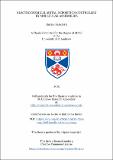Files in this item
Electrochemical metal deposition controlled by molecular assemblies
Item metadata
| dc.contributor.advisor | Buck, Manfred | |
| dc.contributor.author | Bartoletti, Enrico | |
| dc.coverage.spatial | 42 p. | en_US |
| dc.date.accessioned | 2015-10-05T13:31:50Z | |
| dc.date.available | 2015-10-05T13:31:50Z | |
| dc.date.issued | 2015-09-24 | |
| dc.identifier.uri | https://hdl.handle.net/10023/7599 | |
| dc.description.abstract | This thesis studies the electrochemical deposition of the metals Pd and Cu on self-assembled monolayers (SAMs) formed on Au substrates. The SAMs are composed of aromatic mercaptans like 4,4′-dipyridyl disulfide or 3-(4-pyridine-4-ylphenyl)propane-1-thiol which are able to coordinate metal ions at their outer surface of the layer. Through an electrochemical reduction metal is deposited on top of the SAM thus, generating a Metal/SAM/Metal sandwich-like structure. Different outcomes arise, since the use of Pd coordinated to the SAM causes the formation of nanoparticles of limited size on top of the organic layer, while the use of Cu electrolyte elicits the formation of normal nanoisland growth. Also experiments in which both Cu and Pd were present at the same time are performed and by this means mixed nanoparticles on top of the organic layer are generated. The structures are created and analysed by cyclic voltammetry. The system in which only Cu is involved shows a potentially unlimited growth of bulk Cu, while the systems in which only Pd is involved or mixed Cu/Pd nanoparticles are created display a self-limiting growth which may be of great interest because it allows the precise tailoring of nanostructures. This thesis studies also the development of patterned structures achieved through chronoamperometric experiments: a substrate is half-immersed in a PdSO₄ solution which selectively coordinates Pd to one part of the SAM. Reduction of the Pd in the presence of Cu electrolyte results in a selective deposition of Cu on the Pd seeded area of the SAM. This procedure allows for a quick, easy and reliable way to create deposition patterns with a cheap setup. The samples are characterised by optical microscopy, scanning electron microscopy and atomic force microscopy. | en_US |
| dc.language.iso | en | en_US |
| dc.publisher | University of St Andrews | |
| dc.rights | Creative Commons Attribution 4.0 International | |
| dc.rights.uri | http://creativecommons.org/licenses/by/4.0/ | |
| dc.subject | Electrochemistry | en_US |
| dc.subject | Organic SAMs | en_US |
| dc.subject | Hybrid layer structure | en_US |
| dc.subject | Copper | en_US |
| dc.subject | Palladium | en_US |
| dc.subject | Nanoparticles | en_US |
| dc.subject.lcc | QD553.B28 | |
| dc.subject.lcsh | Electroplating | en_US |
| dc.subject.lcsh | Electrochemistry | en_US |
| dc.subject.lcsh | Monomolecular films | en_US |
| dc.subject.lcsh | Nanoparticles | en_US |
| dc.title | Electrochemical metal deposition controlled by molecular assemblies | en_US |
| dc.type | Thesis | en_US |
| dc.contributor.sponsor | Engineering and Physical Sciences Research Council (EPSRC) | en_US |
| dc.type.qualificationlevel | Doctoral | en_US |
| dc.type.qualificationname | MPhil Master of Philosophy | en_US |
| dc.publisher.institution | The University of St Andrews | en_US |
| dc.identifier.doi | https://doi.org/10.17630/10023-7599 |
This item appears in the following Collection(s)
Except where otherwise noted within the work, this item's licence for re-use is described as Creative Commons Attribution 4.0 International
Items in the St Andrews Research Repository are protected by copyright, with all rights reserved, unless otherwise indicated.


